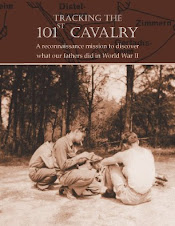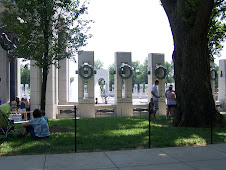
Photo: Clouds of black smoke pour from a German oil refinery in Wehrden after an attack by an American P-47 on February 25. Photo was taken by Lt. John Moors, U.S. Army Signal Corps.
I spent a couple of days recently in the National Archives in College Park, Maryland, and a few hot hours at the World War II Memorial in Washington, D.C.
The National Archives has six or seven boxes of records from the 101st Cavalry: after action reports, daily journals, orders, copies of messages received and sent from headquarters, periodic summaries, lists of all those who received Purple Hearts, and a few other bits and pieces of the history of the unit. One day was not nearly enough time to go through the hundreds of messages, many of which, without the context, were meaningless. A few of the handwritten messages provided enough information to be interesting:
February 15, 1945
Houses on fire in Wadgassen. Started with three houses and continued to grow. Troop B heard the sound of small arms fire from Hill 283. A sniper wounded 1st Lt. G.L. Bricker.
Like many others who were wounded, but received no Purple Heart – Earl Carmickle, Andrew Matanin, Bill Hart – Bricker’s name does not show up on the list of all those in the 101st who did receive a Purple Heart.
February 24, 1945
Patrolling 283 Tec 5 John Romano and PFC Bauldwin Moore stepped on a mine and were wounded.
April 27
Found 1,000 Russian prisoners in a camp (location 304532). At 11:30 bridge was declared OK, wood in good condition, 20-ton capacity needs extra flooring if tanks cross.
On the fifth floor of the archives, in the Still Photos Room, are more than one million photos from World War II, most of them taken by the U.S. Army Signal Corps or Office of War Information. The organizational system isn’t perfect, but the staff members are so helpful that it doesn’t matter. There are only four times per day the staff pulls records (five on Thursday and Friday), and you can request all the boxes of photos you need at those times. I requested eight boxes of photos my first day and found more than a dozen good photos of the 101st Cavalry.
The first day, I spent nine hours with my head in the files, barely taking time for a break. This is common, one member of the staff told me. She said that staff members often will encourage patrons to get up, get a drink, and walk around. It’s always a race against the clock, and there are so many records and photos to see before closing time.
The National Archives has six or seven boxes of records from the 101st Cavalry: after action reports, daily journals, orders, copies of messages received and sent from headquarters, periodic summaries, lists of all those who received Purple Hearts, and a few other bits and pieces of the history of the unit. One day was not nearly enough time to go through the hundreds of messages, many of which, without the context, were meaningless. A few of the handwritten messages provided enough information to be interesting:
February 15, 1945
Houses on fire in Wadgassen. Started with three houses and continued to grow. Troop B heard the sound of small arms fire from Hill 283. A sniper wounded 1st Lt. G.L. Bricker.
Like many others who were wounded, but received no Purple Heart – Earl Carmickle, Andrew Matanin, Bill Hart – Bricker’s name does not show up on the list of all those in the 101st who did receive a Purple Heart.
February 24, 1945
Patrolling 283 Tec 5 John Romano and PFC Bauldwin Moore stepped on a mine and were wounded.
April 27
Found 1,000 Russian prisoners in a camp (location 304532). At 11:30 bridge was declared OK, wood in good condition, 20-ton capacity needs extra flooring if tanks cross.
On the fifth floor of the archives, in the Still Photos Room, are more than one million photos from World War II, most of them taken by the U.S. Army Signal Corps or Office of War Information. The organizational system isn’t perfect, but the staff members are so helpful that it doesn’t matter. There are only four times per day the staff pulls records (five on Thursday and Friday), and you can request all the boxes of photos you need at those times. I requested eight boxes of photos my first day and found more than a dozen good photos of the 101st Cavalry.
The first day, I spent nine hours with my head in the files, barely taking time for a break. This is common, one member of the staff told me. She said that staff members often will encourage patrons to get up, get a drink, and walk around. It’s always a race against the clock, and there are so many records and photos to see before closing time.
With temperatures around 100 degrees and humidity high, it wasn’t a good time for walking around the Washington National Mall, but I did make time and find the energy for a short trip to the World War II Memorial. It’s beautiful, and I certainly encourage you to make sure you or your relatives who served in World War II are listed in its registry. The link is listed with all the other web links on this blog.





No comments:
Post a Comment